Integrated Physical Microstructure and Mechanical Performance Analysis of the Failure Mechanism of Weakly Cemented Sandstone Under Long-Term Water Immersion
Abstract
1. Introduction
2. Methodology
2.1. Preparation of Rock Samples
2.2. Experimental Procedure and Equipment
3. Analysis of Test Results
3.1. Structure and Composition of Rock Samples
3.2. SEM Test Results
3.3. Uniaxial Compression Test Results
3.3.1. Basic Mechanical Indicators
3.3.2. Failure Modes
3.4. Acoustic Emission Characteristics
3.4.1. Energy Rate Characteristics
3.4.2. Impact Characteristics
3.4.3. Main Frequency Characteristics
4. Discussion
5. Conclusions
Author Contributions
Funding
Institutional Review Board Statement
Informed Consent Statement
Data Availability Statement
Conflicts of Interest
References
- Wang, C.; Min, H.; Zhu, T.; Wang, H.; Qin, W.; Zhang, G. Failure mechanism and stability analysis of the landslide: A case study for open pit iron mine in Xichang, Sichuan, China. Nat. Hazards 2023, 116, 663–691. [Google Scholar] [CrossRef]
- Zhang, Y.; Zhang, Z.; Xue, S.; Wang, R.; Xiao, M. Stability analysis of a typical landslide mass in the Three Gorges Reservoir under varying reservoir water levels. Environ. Earth Sci. 2020, 79, 42. [Google Scholar] [CrossRef]
- Li, J.; Gao, Y.; Yang, T.; Zhang, P.; Zhao, Y.; Deng, W.; Liu, H.; Liu, F. Integrated simulation and monitoring to analyze failure mechanism of the anti-dip layered slope with soft and hard rock interbedding. Int. J. Min. Sci. Technol. 2023, 33, 1147–1164. [Google Scholar] [CrossRef]
- Nie, L.; Li, Z.; Zhang, M.; Xu, L. Deformation characteristics and mechanism of the landslide in West Open-Pit Mine, Fushun, China. Arab. J. Geosci. 2015, 8, 4457–4468. [Google Scholar] [CrossRef]
- Zhang, Z.; Gao, F. Experimental investigation on the energy evolution of dry and water-saturated red sandstones. Int. J. Min. Sci. Technol. 2015, 25, 383–388. [Google Scholar] [CrossRef]
- Kim, E.; Stine, M.A.; de Oliveira, D.B.M.; Changani, H. Correlations between the physical and mechanical properties of sandstones with changes of water content and loading rates. Int. J. Rock Mech. Min. Sci. 2017, 100, 255–262. [Google Scholar] [CrossRef]
- Cai, X.; Cheng, C.; Zhao, Y.; Zhou, Z.; Wang, S. The role of water content in rate dependence of tensile strength of a fine-grained sandstone. Archiv. Civ. Mech. Eng. 2022, 22, 58. [Google Scholar] [CrossRef]
- Li, J.; Gao, Y.; Yang, T.; Zhang, P.; Deng, W.; Liu, F. Effect of water on the rock strength and creep behavior of green mudstone. Geomech. Geophys. Geo Energy Geo-Resour. 2023, 9, 101. [Google Scholar] [CrossRef]
- Li, H.; Qiao, Y.; Shen, R.; He, M.; Cheng, T.; Xiao, Y.; Tang, J. Effect of water on mechanical behavior and acoustic emission response of sandstone during loading process: Phenomenon and mechanism. Eng. Geol. 2021, 294, 106386. [Google Scholar] [CrossRef]
- Li, X.-f.; Du, K.; Zhou, J.; Yin, Z.-q. Failure behaviors of square-tunnel-structured rock specimens under various inclined boundary stress conditions. Eng. Fail. Anal. 2024, 157, 107888. [Google Scholar] [CrossRef]
- Xu, R.; Hu, Y.; Yan, Z.; Zhao, Y.; Li, Z. Experimental Investigation on the Effect of Water Saturation on the Failure Mechanism and Acoustic Emission Characteristics of Sandstone. Int. J. Geomech. 2024, 24, 04024102. [Google Scholar] [CrossRef]
- Zhou, Z.; Cai, X.; Ma, D.; Cao, W.; Chen, L.; Zhou, J. Effects of water content on fracture and mechanical behavior of sandstone with a low clay mineral content. Eng. Fract. Mech. 2018, 193, 47–65. [Google Scholar] [CrossRef]
- Zhao, K.; Yang, D.; Zeng, P.; Huang, Z.; Wu, W.; Li, B.; Teng, T. Effect of water content on the failure pattern and acoustic emission characteristics of red sandstone. Int. J. Rock Mech. Min. Sci. 2021, 142, 104709. [Google Scholar] [CrossRef]
- Chen, J.; Ye, Y.; Pu, Y.; Xu, W.; Mengli, D. Experimental study on uniaxial compression failure modes and acoustic emission characteristics of fissured sandstone under water saturation. Theor. Appl. Fract. Mech. 2022, 119, 103359. [Google Scholar] [CrossRef]
- Han, P.; Zhao, Y.; Zhang, C.; Wang, X. Progressive Damage Characteristic and Microscopic Weakening Mechanism of Coal Under Long-Term Soaking. Rock Mech. Rock Eng. 2023, 56, 7861–7881. [Google Scholar] [CrossRef]
- Li, M.; Lin, G.; Zhou, W.; Mao, X.; Zhang, L.; Mao, R.; Karinski, Y.S. Experimental Study on Dynamic Tensile Failure of Sandstone Specimens with Different Water Contents. Shock Vib. 2019, 2019, 7012752. [Google Scholar] [CrossRef]
- Qin, X.; Zhang, H.; Xu, R.; Zhang, J.; Yuan, C. Experimental investigation on the failure mechanism of grouted rock mass: Mesostructure and macroscopic mechanical behavior. Eng. Fail. Anal. 2024, 161, 108304. [Google Scholar] [CrossRef]
- Safari, H.; Balcom, B.J.; Afrough, A. Characterization of pore and grain size distributions in porous geological samples—An image processing workflow. Comput. Geosci. 2021, 156, 104895. [Google Scholar] [CrossRef]
- Wang, X.; Liu, Y.; Hou, J.; Wang, D.; Ji, L.; Sun, J.; Li, Y.; Yan, X. Impacts of water flooding on pore structure of sandstone reservoirs—Case study of Wang Guantun oilfield, Bohai Bay Basin, China. Arab. J. Geosci. 2018, 11, 580. [Google Scholar] [CrossRef]
- Fang, X.; Xu, J.; Wang, P. Compressive failure characteristics of yellow sandstone subjected to the coupling effects of chemical corrosion and repeated freezing and thawing. Eng. Geol. 2018, 233, 160–171. [Google Scholar] [CrossRef]
- Ping, Q.; Wang, C.; Gao, Q.; Shen, K.; Wu, Y.; Wang, S.; Li, X.; Jiang, Q. Experimental Study on Dynamic Compression Mechanics of Sandstone After Coupled Alkali-Chemical-Dynamic Interaction. Adv. Civ. Eng. 2022, 2022, 1970591. [Google Scholar] [CrossRef]
- You, S.; Ji, H.; Wang, T.; Song, Z. Thermal and mechanical coupling effects on permeability of weakly cemented sandstone. Emerg. Mater. Res. 2018, 7, 100–108. [Google Scholar] [CrossRef]
- Chai, Z.; Bai, J.; Sun, Y. Change of pore structure and Uniaxial compressive strength of sandstone under electrochemical coupling. Geomech. Eng. 2019, 17, 157–164. [Google Scholar] [CrossRef]
- Shi, H.; Zhang, H.; Song, L. Evolution of sandstone shear strength parameters and its mesoscopic mechanism. Geomech. Eng. 2020, 20, 29–41. [Google Scholar] [CrossRef]
- Zhao, J.; Tan, Z.; Wang, X.; Zhou, Z.; Li, G. Engineering characteristics of water-bearing weakly cemented sandstone and dewatering technology in tunnel excavation. Tunn. Undergr. Space Technol. 2022, 121, 104316. [Google Scholar] [CrossRef]
- Awadh, S.M.; Al-Sulttani, A.H.; Yaseen, Z.M. Temporal dynamic drought interpretation of Sawa Lake: Case study located at the Southern Iraqi region. Nat. Hazards 2022, 112, 619–638. [Google Scholar] [CrossRef]
- Bai, Y.; Shan, R.; Ju, Y.; Wu, Y.; Sun, P.; Wang, Z. Study on the mechanical properties and damage constitutive model of frozen weakly cemented red sandstone. Cold Reg. Sci. Technol. 2020, 171, 102980. [Google Scholar] [CrossRef]
- Brouwers, L.B. A Closer Look: Petrographic Analysis of Extremely Weak Sandstone/Cemented Sand of the Ghayathi Formation, Dubai, UAE. In International Congress and Exhibition “Sustainable Civil Infrastructures”; Springer International Publishing: Cham, Switzerland, 2020; pp. 12–19. [Google Scholar]
- Wang, Z.; Li, W.; Wang, Q.; Liu, S.; Hu, Y.; Fan, K. Relationships between the petrographic, physical and mechanical characteristics of sedimentary rocks in Jurassic weakly cemented strata. Environ. Earth Sci. 2019, 78, 131. [Google Scholar] [CrossRef]
- Zhang, Y.; Shao, J.F.; Xu, W.Y.; Sun, H.K. Stability analysis of a large landslide in hydropower engineering. Nat. Hazards 2014, 70, 527–548. [Google Scholar] [CrossRef]
- Fan, G.; Chen, M.; Zhang, D.; Wang, Z.; Zhang, S.; Zhang, C.; Li, Q.; Cao, B. Experimental Study on the Permeability of Weakly Cemented Rock under Different Stress States in Triaxial Compression Tests. Geofluids 2018, 2018, 9035654. [Google Scholar] [CrossRef]
- Zhang, W.; Zhang, D.; Han, C.; Ren, Q.; Zhou, W.; Wei, J. Experimental investigation of the microstructural evolution of weakly cemented sandstone under seepage erosion. Bull. Eng. Geol. Environ. 2023, 82, 440. [Google Scholar] [CrossRef]
- Cai, X.; Zhou, Z.; Zang, H.; Song, Z. Water saturation effects on dynamic behavior and microstructure damage of sandstone: Phenomena and mechanisms. Eng. Geol. 2020, 276, 105760. [Google Scholar] [CrossRef]
- Liu, Q.; Sun, Y.J.; Li, J. Experimental Study on Seepage Characteristics of Jurassic Weakly Cemented Sandstone Under Water-Rock Interaction. Geofluids 2020, 2020, 8543687. [Google Scholar] [CrossRef]
- Yu, J.X.; Duffaut, K.; Avseth, P. Stress sensitivity of elastic moduli in high-porosity cemented sandstone-Heuristic models and experimental data. Geophysics 2023, 88, MR185–MR194. [Google Scholar] [CrossRef]
- Zhou, Z.L.; Cai, X.; Li, X.B.; Cao, W.Z.; Du, X.M. Dynamic Response and Energy Evolution of Sandstone Under Coupled Static-Dynamic Compression: Insights from Experimental Study into Deep Rock Engineering Applications. Rock Mech. Rock Eng. 2020, 53, 1305–1331. [Google Scholar] [CrossRef]
- Miao, S.T.; Pan, P.Z.; Zhao, X.G.; Shao, C.Y.; Yu, P.Y. Experimental Study on Damage and Fracture Characteristics of Beishan Granite Subjected to High-Temperature Treatment with DIC and AE Techniques. Rock Mech. Rock Eng. 2021, 54, 721–743. [Google Scholar] [CrossRef]
- Zhang, Y.; Wu, W.; Yao, X.; Liang, P.; Sun, L.; Liu, X. Study on Spectrum Characteristics and Clustering of Acoustic Emission Signals from Rock Fracture. Circuits Syst. Signal Process. 2019, 39, 1133–1145. [Google Scholar] [CrossRef]
- Eaton, D.W.; van der Baan, M.; Birkelo, B.; Tary, J.-B. Scaling relations and spectral characteristics of tensile microseisms: Evidence for opening/closing cracks during hydraulic fracturing. Geophys. J. Int. 2014, 196, 1844–1857. [Google Scholar] [CrossRef]
- Yang, C.; Mao, H.; Huang, X.; Wang, X. Study on the variation on micostructure and mechanical properties of water-weakening slates. In Proceedings of EUROCK; Rock and Soil Mechanics: Wuhan, China, 2006; pp. 173–182. [Google Scholar]
- Jia, H.; Ding, S.; Wang, Y.; Zi, F.; Sun, Q.; Yang, G. An NMR-based investigation of pore water freezing process in sandstone. Cold Reg. Sci. Technol. 2019, 168, 102893. [Google Scholar] [CrossRef]
- Laird, D.A. Influence of layer charge on swelling of smectites. Appl. Clay Sci. 2006, 34, 74–87. [Google Scholar] [CrossRef]
- Shen, X.Y.; Zheng, X.J.; Bourg, I.C. A coarse-grained model of clay colloidal aggregation and consolidation with explicit representation of the electrical double layer. J. Colloid Interface Sci. 2025, 683, 1188–1196. [Google Scholar] [CrossRef]
- He, Y.L.; Niu, W.Z.; Gao, Z.W.; Dong, H.; An, S.Z.; Han, C.C.; Zhao, L. Adsorption Behavior of Asphaltene on Clay Minerals and Quartz in a Heavy Oil Sandstone Reservoir with Thermal Damage. Clays Clay Miner. 2022, 70, 120–134. [Google Scholar] [CrossRef]
- Wenk, H.R.; Bulakh, A. Minerals: Their Constitution and Origin; Cambridge University Press: Cambridge, UK, 2004. [Google Scholar]
- Rahromostaqim, M.; Sahimi, M. Molecular Dynamics Study of the Effect of Layer Charge and Interlayer Cations on Swelling of Mixed-Layer Chlorite-Montmorillonite Clays. J. Phys. Chem. C 2020, 124, 2553–2561. [Google Scholar] [CrossRef]
- Bian, K.; Liu, J.; Zhang, W.; Zheng, X.; Ni, S.; Liu, Z. Mechanical Behavior and Damage Constitutive Model of Rock Subjected to Water-Weakening Effect and Uniaxial Loading. Rock Mech. Rock Eng. 2019, 52, 97–106. [Google Scholar] [CrossRef]
- Rehbinder, P.; Lichtman, V. Effect of Surface Active Media on Strain and Rupture in Solids. In Proceedings of the Second International Congress of Surface Activity, London, UK, 8–13 April 1957; pp. 563–580. [Google Scholar]
- Li, Z.Q.; Nie, L.C.; Xue, Y.G.; Li, Y.; Tao, Y.F. Experimental Investigation of Progressive Failure Characteristics and Permeability Evolution of Limestone: Implications for Water Inrush. Rock Mech. Rock Eng. 2024, 57, 4635–4652. [Google Scholar] [CrossRef]
- Yang, Y.T.; Tang, X.H.; Zheng, H.; Liu, Q.S.; Liu, Z.J. Hydraulic fracturing modeling using the enriched numerical manifold method. Appl. Math. Model. 2018, 53, 462–486. [Google Scholar] [CrossRef]
- Yan, C.Z.; Xie, X.; Ren, Y.H.; Ke, W.H.; Wang, G. A FDEM-based 2D coupled thermal-hydro-mechanical model for multiphysical simulation of rock fracturing. Int. J. Rock Mech. Min. Sci. 2022, 149, 104964. [Google Scholar] [CrossRef]
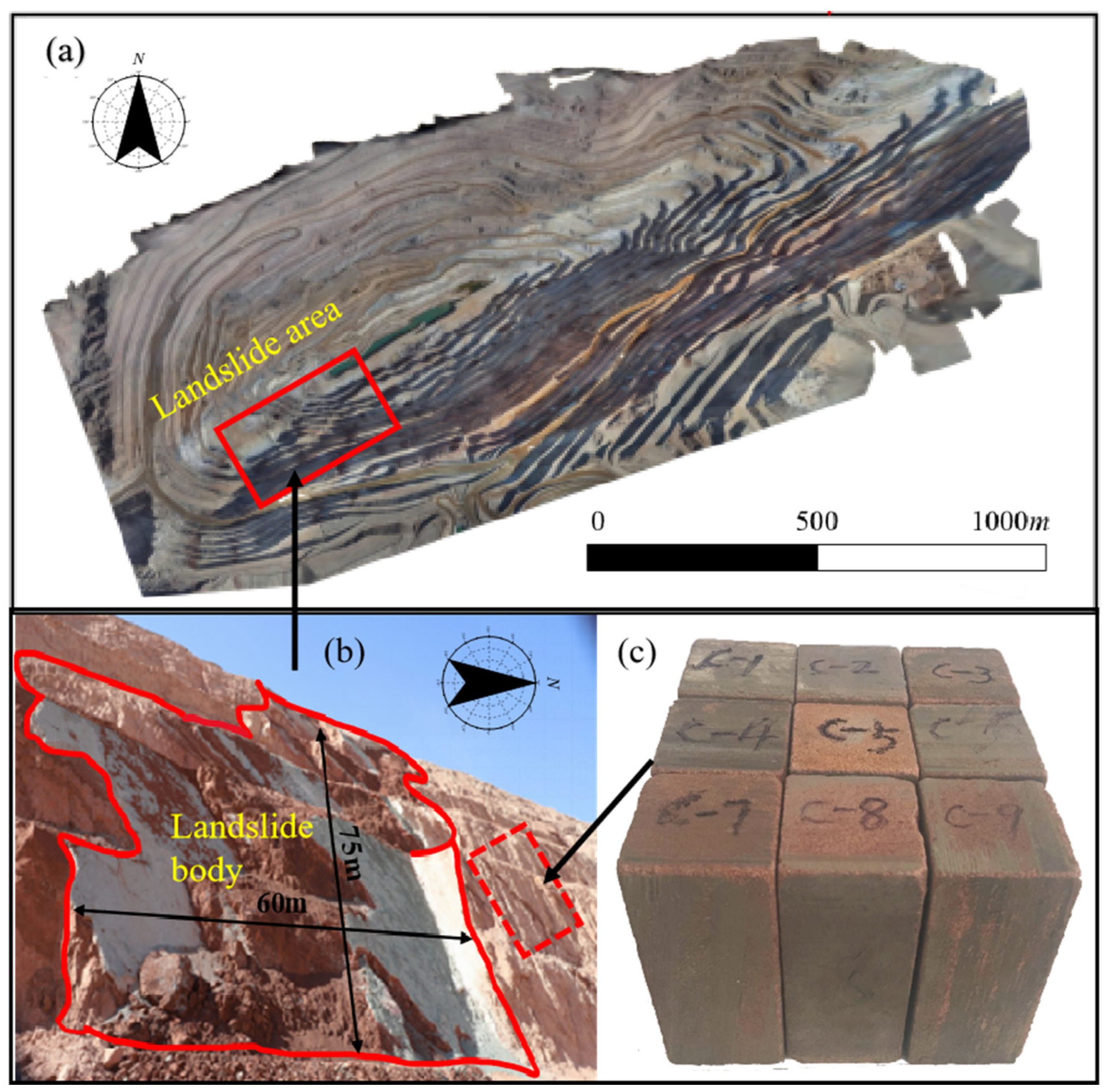
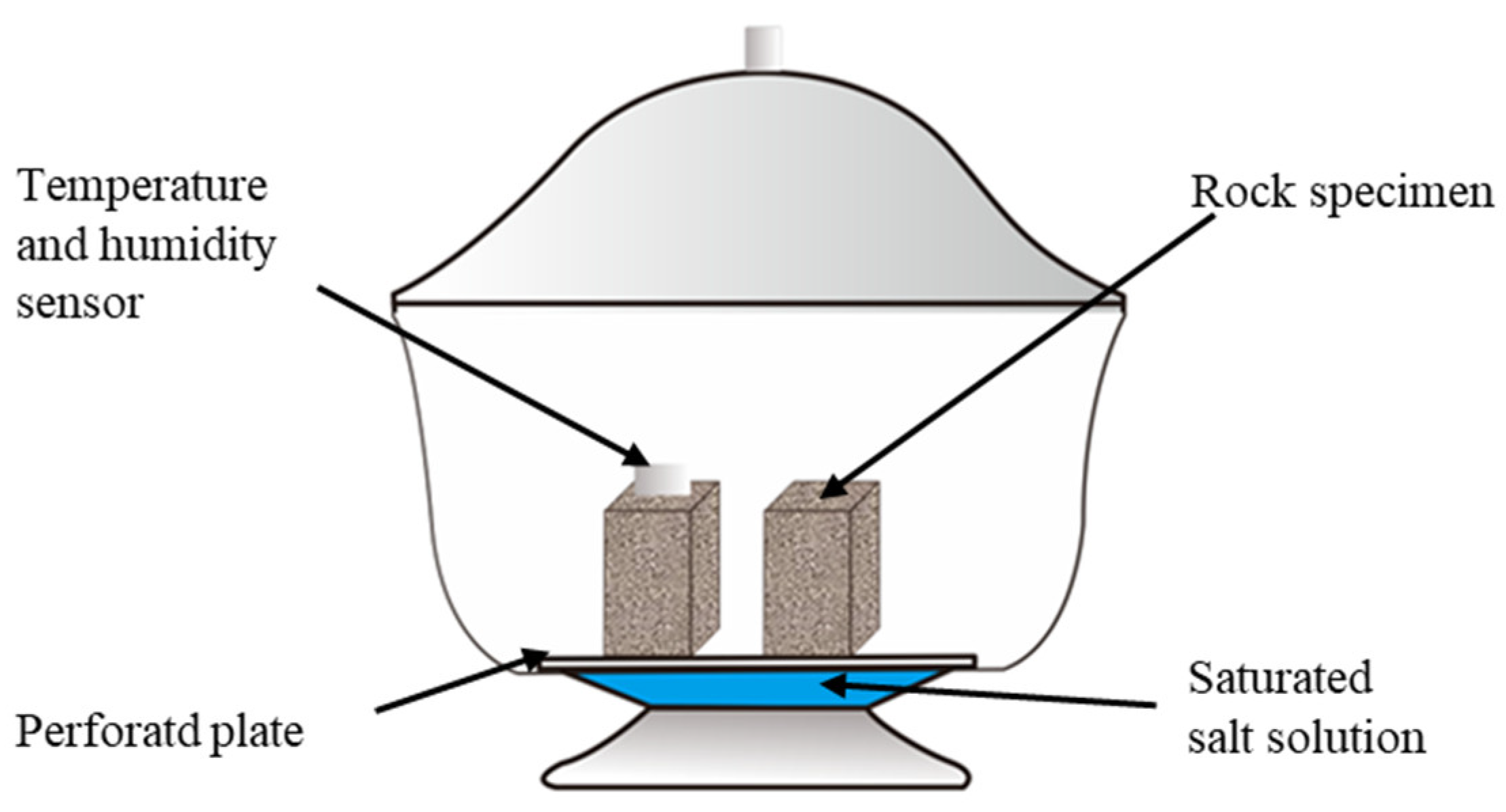
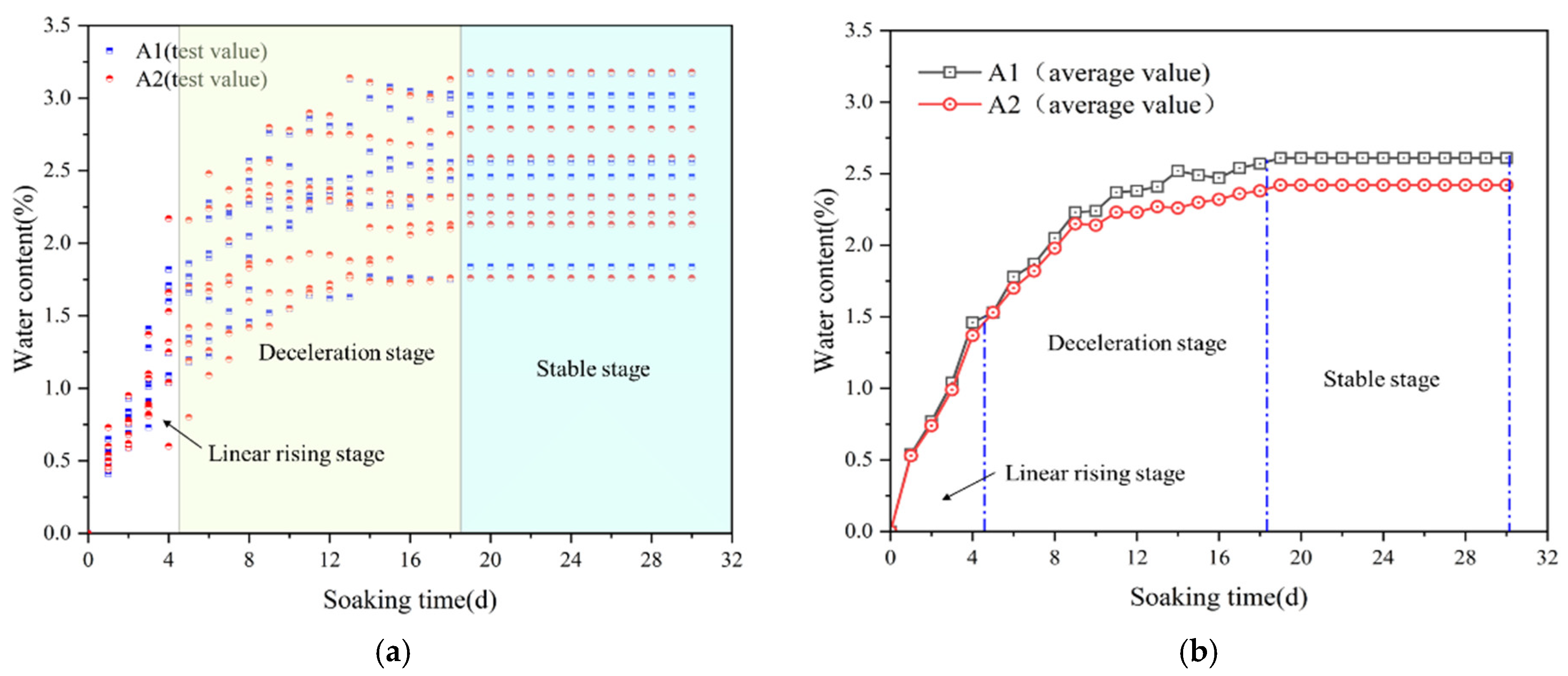
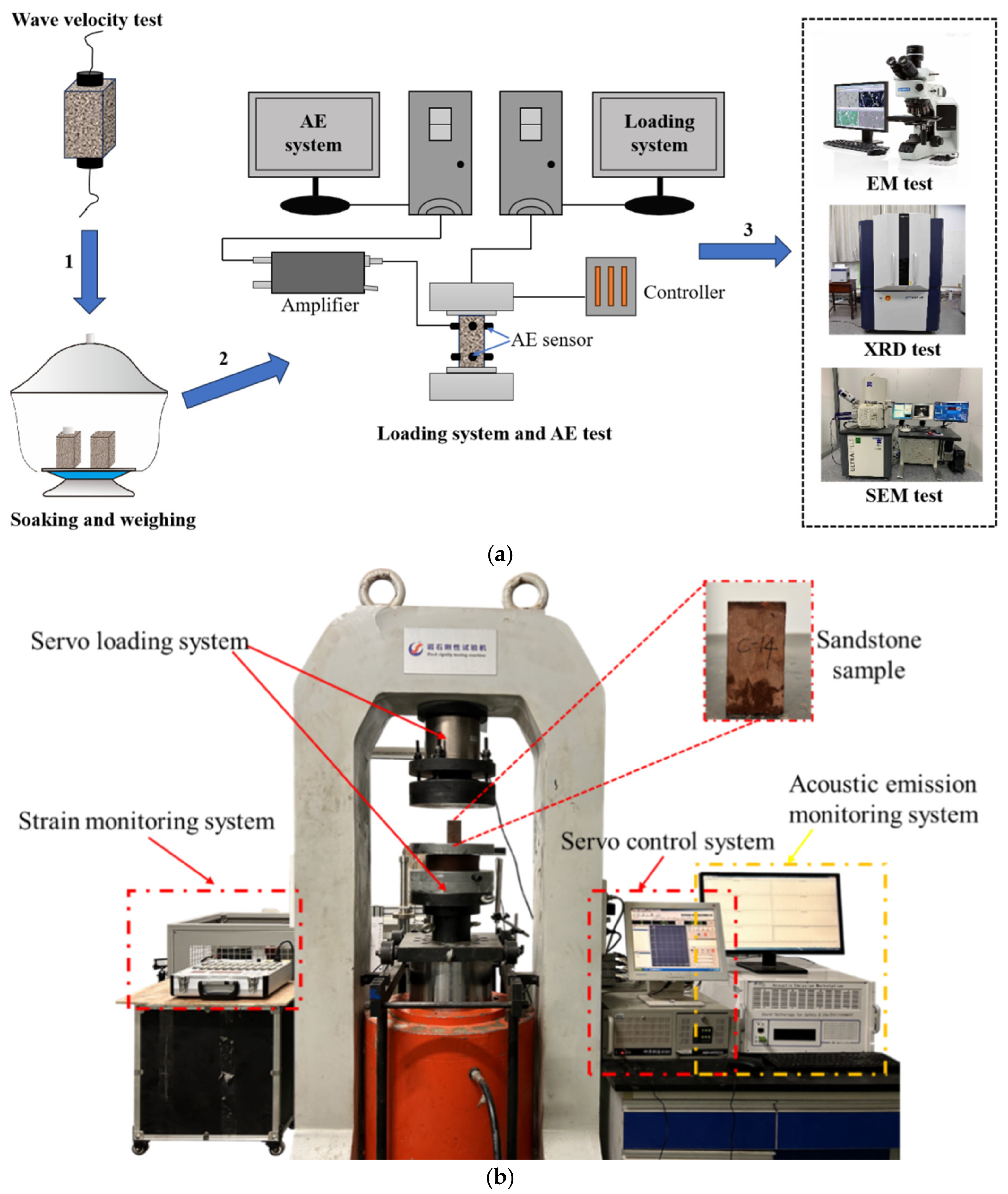
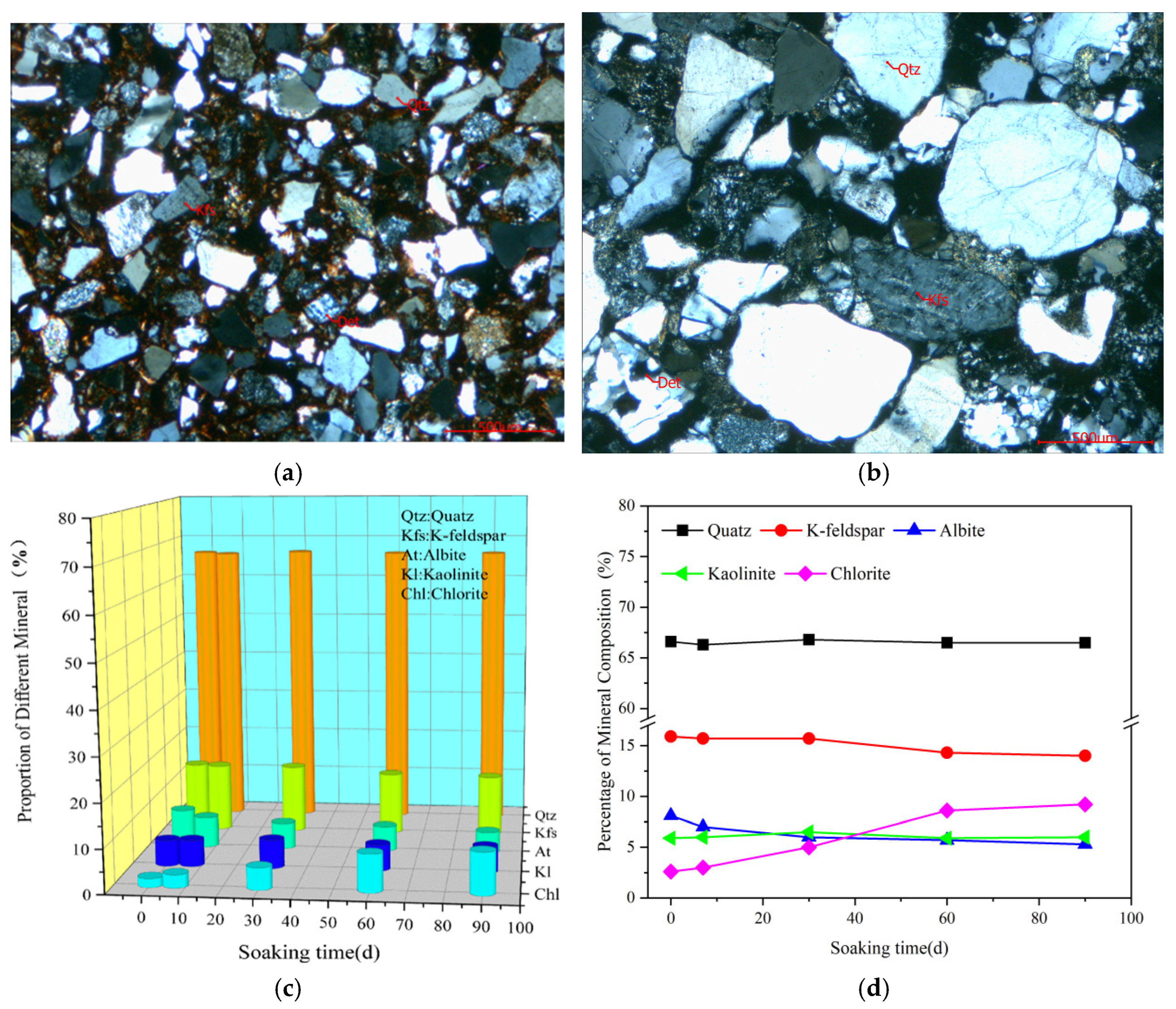
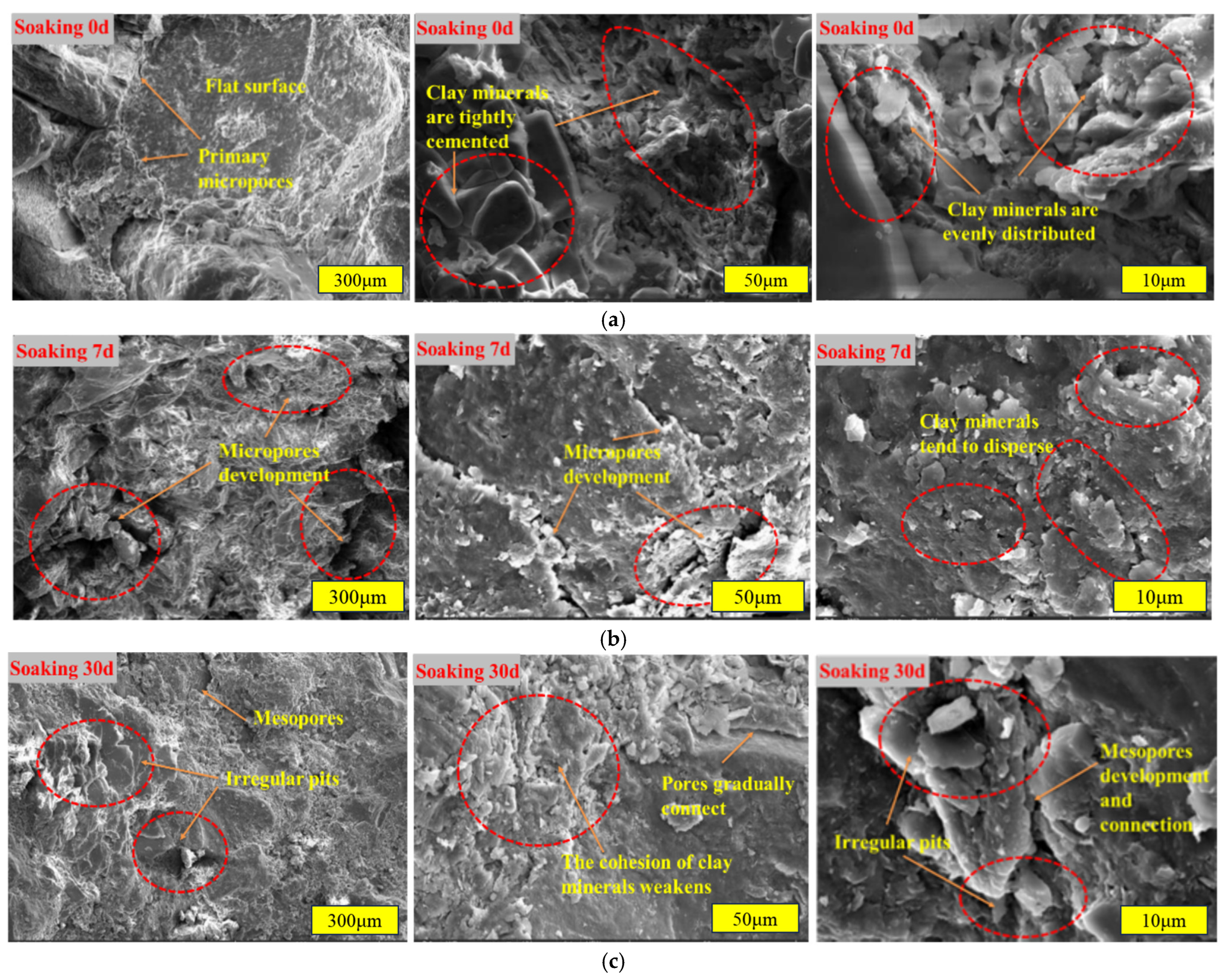


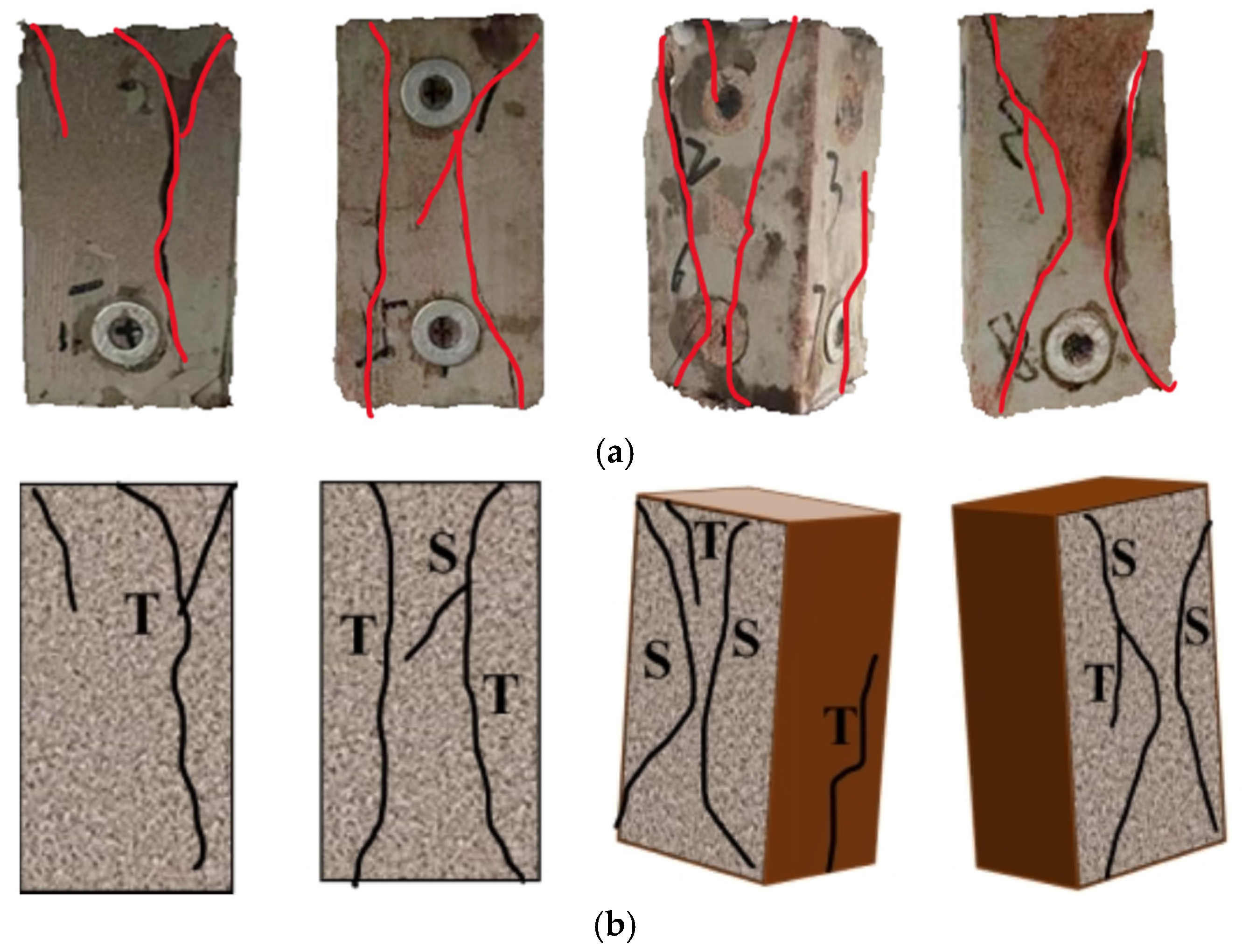
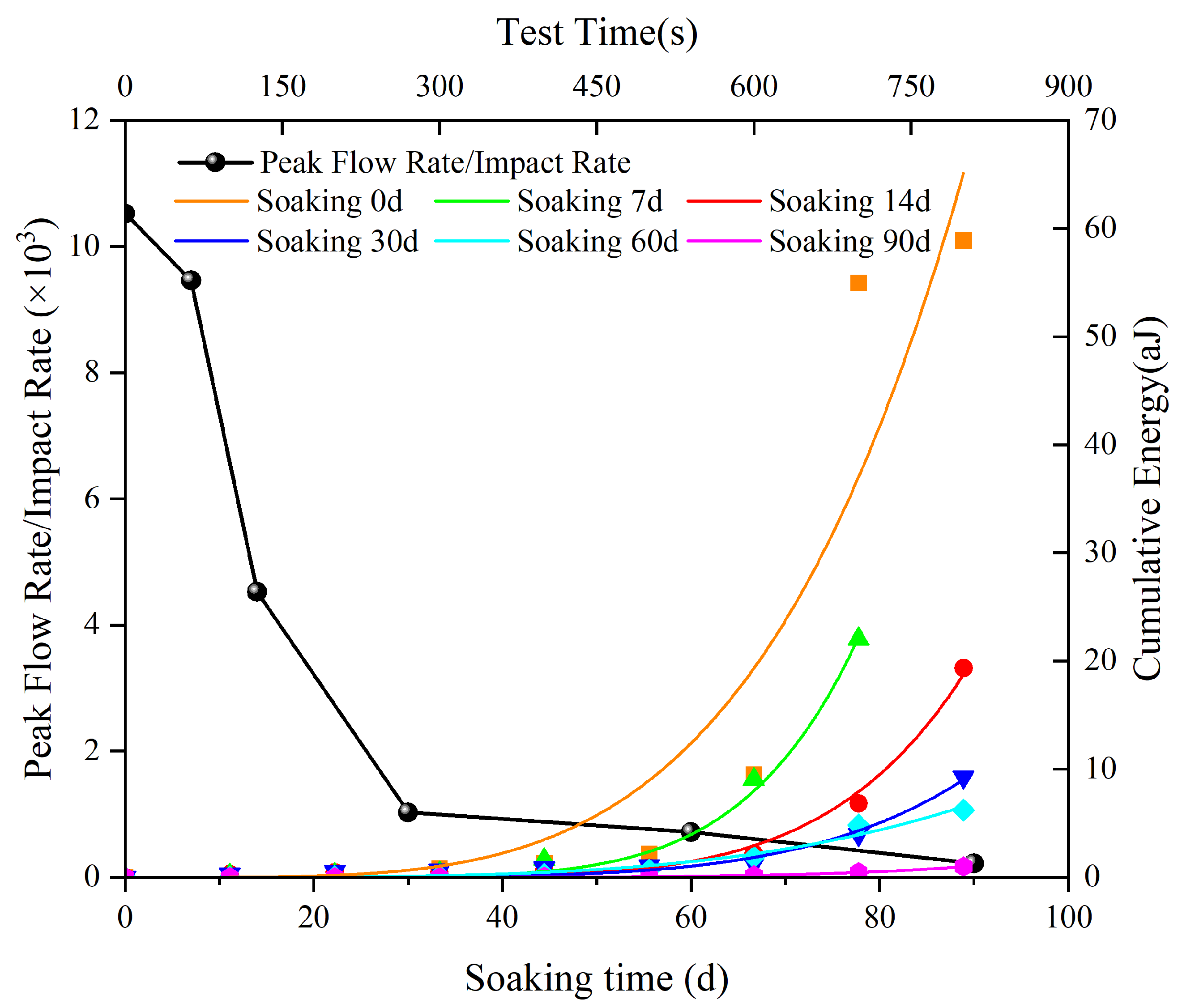
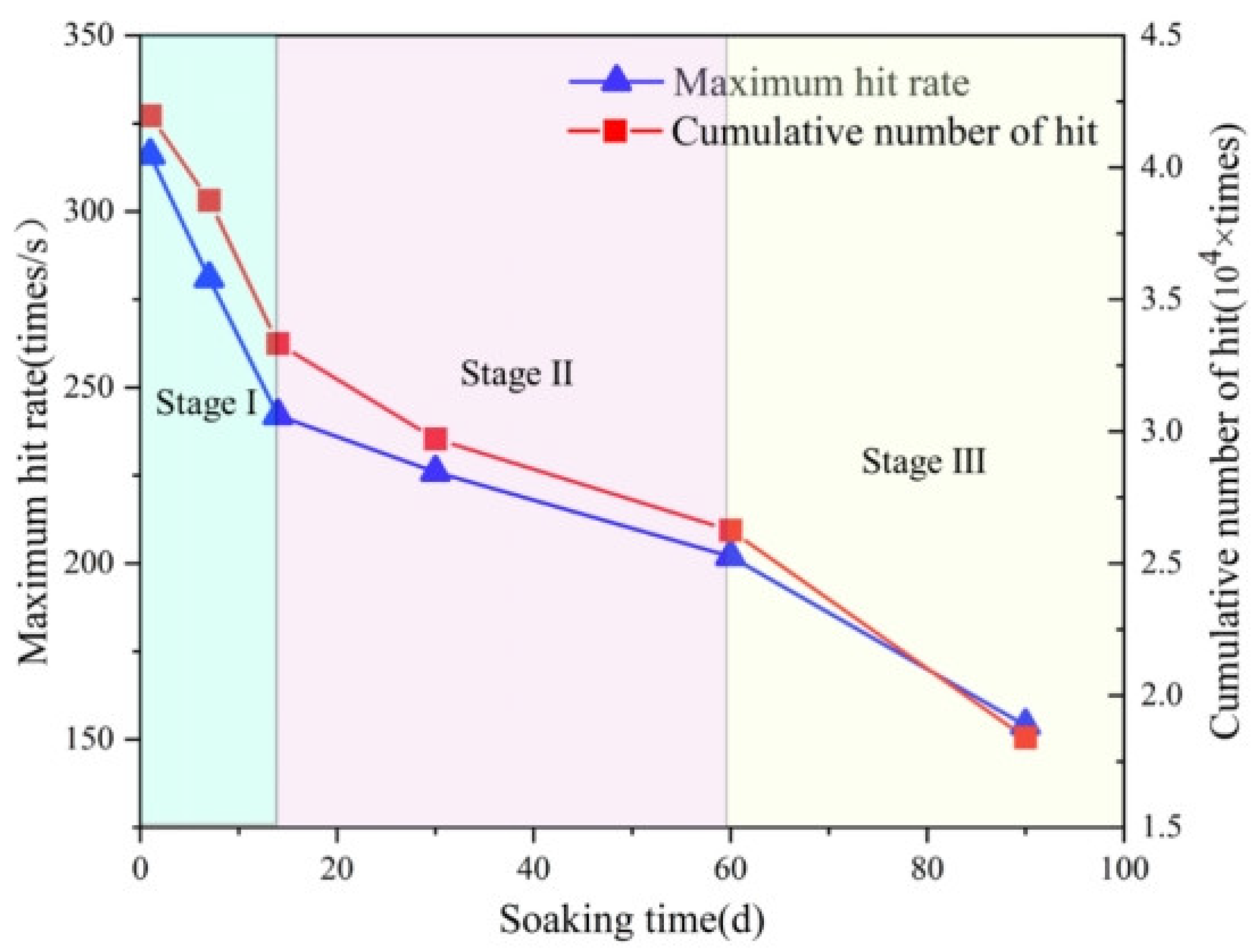

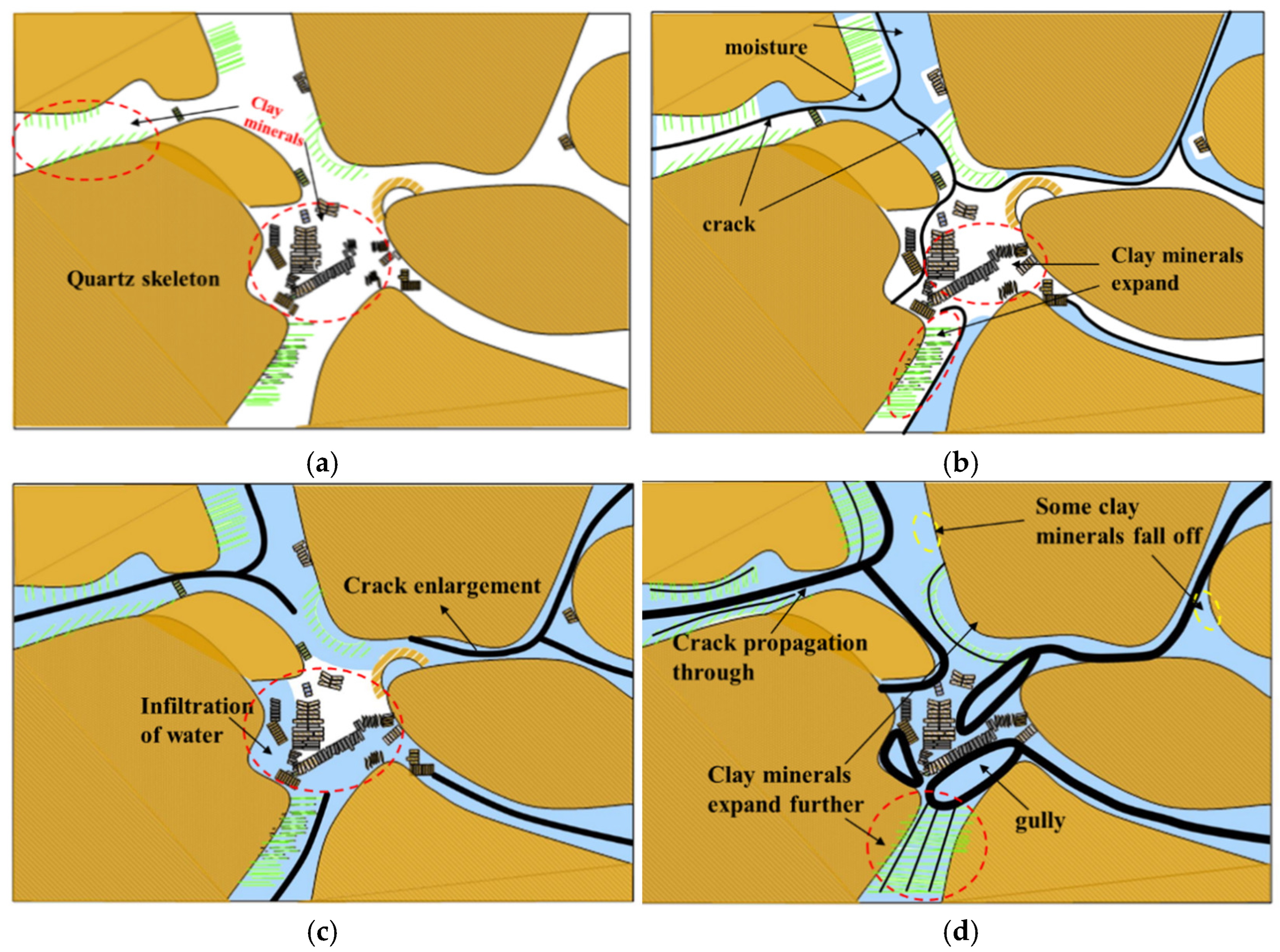
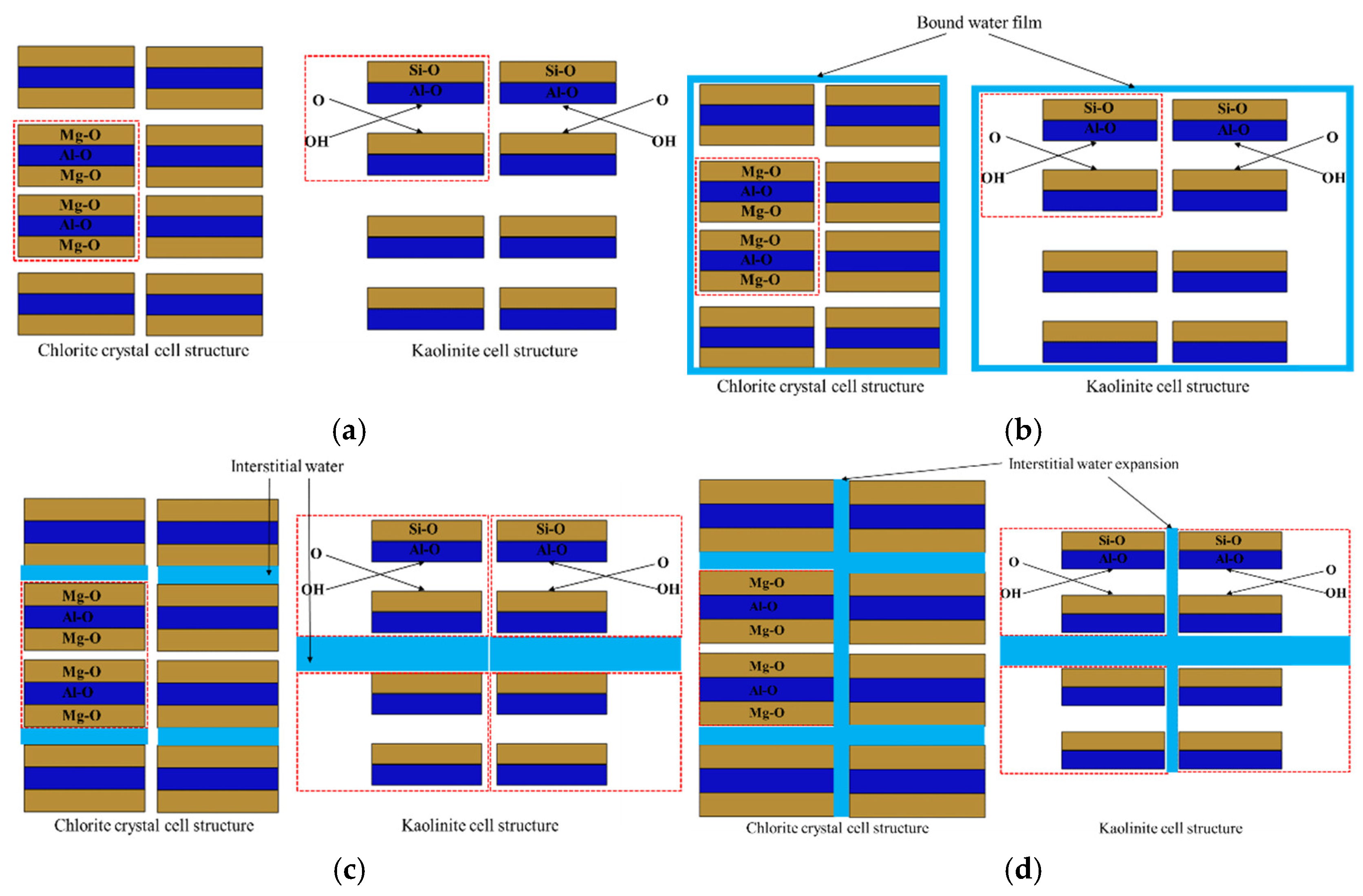
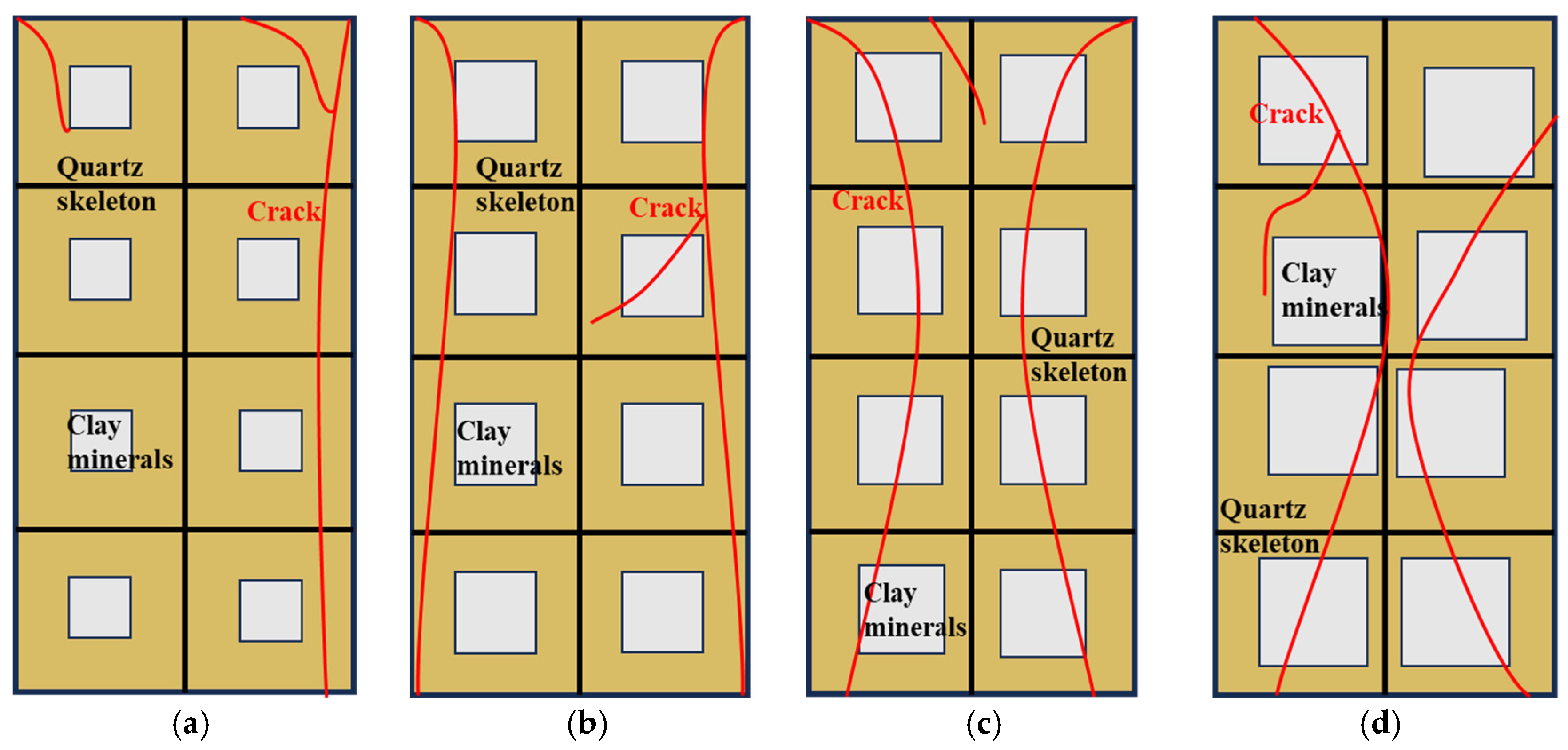
| Sample | Soaking Time/d | Peak Stress/MPa | Peak Strain | Elastic Modulus/MPa | |||
|---|---|---|---|---|---|---|---|
| Tested | Average | Tested | Average | Tested | Average | ||
| A0-1 | 0 | 17.1 | 17.0 | 0.1031 | 0.1033 | 934.2 | 931.4 |
| A0-2 | 16.9 | 0.1035 | 926.8 | ||||
| A1-1 | 7 | 12.6 | 12.0 | 0.1087 | 0.1088 | 594.2 | 591.4 |
| A2-3 | 11.4 | 0.1089 | 588.6 | ||||
| A1-5 | 14 | 10.5 | 9.5 | 0.1356 | 0.1381 | 440.8 | 440.3 |
| A2-5 | 8.5 | 0.1406 | 439.8 | ||||
| A1-2 | 30 | 8.4 | 7.9 | 0.1539 | 0.1481 | 318.5 | 316.3 |
| A2-6 | 7.4 | 0.1423 | 314.1 | ||||
| A1-6 | 60 | 3.9 | 4.1 | 0.1754 | 0.1748 | 211.4 | 210.0 |
| A2-4 | 4.3 | 0.1742 | 208.6 | ||||
| A1-7 | 90 | 3.6 | 3.0 | 0.1922 | 0.1870 | 112.1 | 108.2 |
| A2-7 | 2.4 | 0.1818 | 104.3 | ||||
| Soaking Time/d | Peak Impact Rate | Decline Rate/% | Cumulative Number of Impacts | Decline Rate/% |
|---|---|---|---|---|
| 0 | 316 | 0 | 41,964 | 0 |
| 7 | 281 | 11.08 | 38,754 | 7.65 |
| 14 | 242 | 23.42 | 33,328 | 20.58 |
| 30 | 226 | 28.48 | 29,722 | 29.17 |
| 60 | 202 | 36.08 | 26,256 | 37.43 |
| 90 | 154 | 51.27 | 18,405 | 56.14 |
Disclaimer/Publisher’s Note: The statements, opinions and data contained in all publications are solely those of the individual author(s) and contributor(s) and not of MDPI and/or the editor(s). MDPI and/or the editor(s) disclaim responsibility for any injury to people or property resulting from any ideas, methods, instructions or products referred to in the content. |
© 2025 by the authors. Licensee MDPI, Basel, Switzerland. This article is an open access article distributed under the terms and conditions of the Creative Commons Attribution (CC BY) license (https://creativecommons.org/licenses/by/4.0/).
Share and Cite
Liu, H.; Zhang, S.; Deng, W.; Li, J.; Yang, T.; Zhou, J. Integrated Physical Microstructure and Mechanical Performance Analysis of the Failure Mechanism of Weakly Cemented Sandstone Under Long-Term Water Immersion. Appl. Sci. 2025, 15, 4777. https://doi.org/10.3390/app15094777
Liu H, Zhang S, Deng W, Li J, Yang T, Zhou J. Integrated Physical Microstructure and Mechanical Performance Analysis of the Failure Mechanism of Weakly Cemented Sandstone Under Long-Term Water Immersion. Applied Sciences. 2025; 15(9):4777. https://doi.org/10.3390/app15094777
Chicago/Turabian StyleLiu, Honglei, Shixian Zhang, Wenxue Deng, Jinduo Li, Tianhong Yang, and Jianhua Zhou. 2025. "Integrated Physical Microstructure and Mechanical Performance Analysis of the Failure Mechanism of Weakly Cemented Sandstone Under Long-Term Water Immersion" Applied Sciences 15, no. 9: 4777. https://doi.org/10.3390/app15094777
APA StyleLiu, H., Zhang, S., Deng, W., Li, J., Yang, T., & Zhou, J. (2025). Integrated Physical Microstructure and Mechanical Performance Analysis of the Failure Mechanism of Weakly Cemented Sandstone Under Long-Term Water Immersion. Applied Sciences, 15(9), 4777. https://doi.org/10.3390/app15094777





